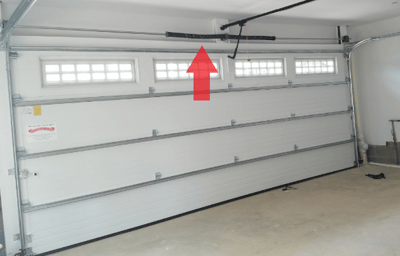High-quality garage doors can last for decades if you take good care of them. On average, a garage door goes up and down more than 1,000 times a year, so it’s really working hard! Given that garage doors are heavy and have many moving parts, including powerful springs, it’s crucial to keep up with monthly inspections and annual preventive maintenance. Doing so not only protects your investment but also keeps you safe.
 Preventive Maintenance for Your Residential Garage Door
Preventive Maintenance for Your Residential Garage Door
It's important to schedule annual preventive maintenance for your garage door to keep it running smoothly. If you’re comfortable with DIY tasks, you can handle most of the maintenance yourself. However, if you'd rather leave it to the experts, a certified garage door technician can help get your door back in top shape. A good time to schedule this is before the weather warms up or at the end of summer.
→ Suggested Lecture: "Summer Home and Garage Door Maintenance Checklist"
.png?width=400&height=257&name=Garage%20Door%20Inspection%20%26%20Prev.%20Maintenance%20in%20NJ%20(5).png) Our Certified Technicians Can Help You Keep Your Door In Shape
Our Certified Technicians Can Help You Keep Your Door In Shape
Essential Tips for Keeping Your Garage Door in Top Shape
To take care of your garage door, you'll need a few basic tools and supplies:
✔ Locking pliers
✔ Socket wrench set
✔ Flat-bladed screwdriver
✔ Pliers
✔ Old toothbrush
✔ Lithium grease
✔ Silicone spray/WD-40
Simple Steps to Keep Your Garage Door Running Smoothly
1. Secure Your Garage Door: Safety is key. Start by unplugging the garage door opener to prevent any accidents. To keep the door from moving while you work, use locking pliers on the roller tracks. Remember, garage doors are under a lot of spring tension, so don’t try to remove the lift cables yourself. And never attempt to adjust the torsion spring on your own—if you need to deal with it, call a professional, as it can be very dangerous if not handled correctly.

2. Tighten Hardware: Grab your socket wrench and check if the rail bracket bolts and roller brackets are loose. Tighten them up if needed to keep everything secure.
3. Inspect Rollers: Nylon rollers can chip and break over time, while steel rollers might get bent or dented. It’s a good idea to replace any worn rollers in your garage door when needed. Just be careful not to remove the bottom roller bracket, as it’s under a lot of spring tension and can be dangerous.
4. Check the Lift Cable: Check the garage door cable for any signs of wear or broken strands, especially at the bottom roller bracket where it attaches. Use a toothbrush to clean off any dirt or buildup. If you spot any damage, it’s best to call a professional for help.

5. Lubricate Opener Hardware:The garage door opener uses a screw, chain, or belt to move the door up and down. If your opener has a screw, apply a small amount of white lithium grease to keep it running smoothly—don’t overdo it. Check your owner's manual to see if your screw opener needs lubrication or not. Typically, the chains are pre-lubricated for life, and the belt doesn’t require any lubrication.
6. Lubricate the Springs: Apply WD-40 or a light coat of oil to the torsion springsto keep them from rusting. Let any extra spray stay as it is. You don’t need to lubricate extension springs. Keep in mind that springs can wear out over time, so if a spring breaks, it’s best to hire a professional to replace it.
7. Lubricate the Garage Door: You don’t need much lubrication to keep your garage door running smoothly. Focus on a few key areas: where the roller shaft meets the bearings, the hinges where they move, and the bearings on the pulleys if you have an extension spring door. Just a small amount is enough—don’t overdo it.
8. Replace the Garage Door Bottom Seal:The weather seal at the bottom of a steel door, known as the "U-shaped astragal," can wear out over time due to weather and pests. To replace it, use a flat-blade screwdriver to open the ends of the channel, remove the old seal, and spray silicone lubricant on the channels. Then, install the new seal and use pliers to crimp the ends in place. Alternatively, you can install a new astragal and retainer. For wood garage doors, you’ll need to remove some roofing nails and carefully nail on a new seal.
9. Side and Top Weather Strip: Most residential garage doors installed in the past 20 years have wood or vinyl stops along the sides and top, often with a vinyl flap to keep out the wind. Over time, this weather strip can wear out. To replace it, you’ll need a hammer and nails that match the color of your door.
10. Test the Door: Start by closing the garage door and make sure the automatic garage door opener is turned off and disconnected from the door. Lift the door manually—it should move up smoothly and stay balanced. If it doesn’t, you might need to call a technician. Next, plug the opener back in and test its safety feature. Place a 2-inch high block of wood in the center of the opening, under the door. This will check if the door’s pressure sensors work correctly. If the door doesn’t reverse when it hits the block, it’s unsafe and you should get it serviced. Also, check the photoelectric-eye or edge sensor to ensure it stops and reverses the door if needed. Clean the lens of the photo-eye if it’s dirty.
→ Suggested Read: "Reset Your Garage Door Opener Emergency Release Cord"
11. Improve Door Safety: If you have an older garage door without modern safety features, it’s a good idea to contact us at Overhead Door Company of Central Jersey for an upgrade or replacement of your automatic garage door opener
Photoelectric eyes, which have been a requirement since 1993, are crucial for safety. If your opener is older and doesn’t have these features, it’s time to consider a new system because it can’t be supported or repaired anymore. Plus, if you plan to sell your home, a home inspector will likely note this issue, so why not upgrade now and enjoy the benefits?
To make it easier to operate your door manually, install lift handles on each side. Use a screw gun to attach them, making sure they’re high enough to avoid hitting the top of the doorframe. This will help prevent pinched fingers.
 Decorative Hardware for Residential Garage Doors
Decorative Hardware for Residential Garage Doors
If your extension-spring door doesn’t have a containment cable to prevent accidents if the springs or cables break, you can buy and install one yourself or get a professional to help. Attach the cable to the bracket at the front of the upper rail with a bolt, feed it through the extension spring, and then secure the other end to the upper support bracket. Loop the cable around the bolt, then tighten it with a fender washer and locknut.
Regular annual maintenance and monthly inspections will keep your garage door running smoothly for years to come. Plus, you’ll enjoy the peace of mind knowing everything is in top shape.
 Residential Service and Repair Experts
Residential Service and Repair Experts
If you have any questions or want to schedule a garage door service in New Jersey, feel free to reach out to us at 908-722-5785 or email us at resi@overheaddoorco.com. We’d be happy to help!



















